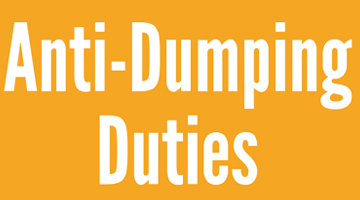A. Whether the Authority has satisfied itself as to the accuracy and adequacy of the information furnished, for purposes of initiating investigations under Rule 5 of the Anti-Dumping Rules?
+ It is clear that the initiation is to be based on the application filed by the domestic industry.
+ The share of Tejas during the POI has been given as 84.7%. CMAI (Communication Multimedia and Infrastructure) has given a letter to the Designated Authority stating as under:
"While the association does not maintain accurate information, with regard to production or supply by different companies or demand in India. We are confident that production of Tejas Networks Ltd is certainty far more than 50% of Indian production. In fact, in our estimate, production of Tejas Networks can be as high as 75% of Indian Production".
+ In our view, the fact that it does not maintain accurate or exact figures of production of each company does not negate the fact that it was well aware that Tejas has a very large share of production in India. Therefore, DA was justified in initiating the investigation. Needless to mention, once the investigations were initiated, opposing parties including other producers had ample opportunity to contest the claim made by Tejas to represent domestic industry having a major proportion in Indian production.
+ DA has also determined for the purposes of initiation that (i) products of the applicants' constitute a major proportion in Indian production, (ii) Domestic producers expressly supporting the application account for significantly more than 50% of production of the like product produced by the domestic industry, (iii) The application has been made by or on behalf of the domestic industry. It has also satisfied itself as to the criteria of standing in terms of Rule 5 of the Rules.
+ No infirmity in the initiation of investigations by the Designated Authority based on the Petition filed by Tejas.
B. Whether Tejas is an eligible domestic industry in terms of Rules 2(b) of the Anti-Dumping Rules?
+ The process flow shows that substantial activities are being carried out by Tejas or by job workers on its behalf both in India and outside India.
+ In order to make SDH equipment in large numbers the services of job workers are utilized in India as well as abroad. Tejas provides the software to the job workers on carrier media. It also shares the designs, specifications and assembly line instruction with them. After processing, the various items are assembled at Tejas factory in Pondicherry and Bangalore. Further software is installed in the boxes so as to enable it to function as aSDH/SONET equipment. We find that the predominant activity is carried out by Tejas and is, therefore, a producer of SDH equipment.
+ About 70% of the total cost of production of the equipment for Tejas is research and development, or cost of development of software, and about 30% is hardware cost. Of the total components used by Tejas, near about 65% are imported. The populated circuit board (containing Tejas software), imported from Thailand, where it is sent for mass production, is the main item of import. The activities carried out by the job worker in Thailand, are only a part of the processes involved in the production of SDH equipment and do not take out Tejas from the category of producer.
+ The second requirement under Rule 2(b) of the Anti-Dumping Rules is that the applicant must have a major proportion in the Indian production.
+ The claim of VMCL and Prithvi that they are domestic producers was based exclusively on the fact that they were paying duties of excise on their products. However, excise duty can be paid by a person under mistaken belief that it was a manufacturer. Also, in the CEA, 1944, there are several deeming fictions to treat certain operations as "manufacture" even if those operations may not amount to manufacture (but for such legal fictions).
+ Thus, mere fact of payment of excise duty would not entitle Prithvi and VMCL to sustain their claim for grant of status as domestic producer. No material was furnished by them to demonstrate the nature of activities carried out by them. They neither filed "importer response" nor "domestic industry response" in the prescribed format. They also did not respond to the specific request of DA for information in this regard. In these circumstances, Designated Authority cannot be faulted for not treating Prithvi and VMCL as domestic producers.
+ We, therefore, do not find any merit in the contention that Tejas is excluded from the category of domestic producer of subject goods in India in terms of Rule 2(b) of Anti-Dumping Rules.
C. Whether the Product under Consideration (PUC) is properly defined, having regard to the statute?
+ In the light of the observations of the Supreme Court in G M Exports - 2015-TIOL-209-SC-CUS, Section 9Aof the Act is to be construed in the same sense as that of the treaty regarding anti-dumping measures.
+ The WTO Panel reports make it amply clear that it is not necessary that all types covered by PUC must be alike to each other or even necessarily constitute a homogenous group. In the present case, the various STMs, are all having SDH technology and are up-gradations of the models having lower numerical value. They are different types of SDH Equipment, which is the product under consideration. Thus, in our view, the determination of product scope by Designated Authority is sustainable.
+ It is permissible for the Authority to include within the purview of the PUC, parts and components, which if not included, would make the levy ineffective. The coverage of the product for levy of duty should be such that the purpose and intent of the levy is achieved. Anti-dumping duty is levied to safeguard the domestic producers from ill effects of dumping. If the parts and components meant for SDH application are excluded, the importers could simply bring the items in different consignments, in unassembled form, and assemble the same in India and defeat the levy.
+ We note that Section 12 of Customs Act, 1962 has no applicability or relevance to the levy of the anti-dumping duty which is levied in terms of Section 9A of the Customs Tariff Act, 1975.
+ As regards the valuation of goods/items which are imported as parts/components embedded in some other goods, it is pertinent to mention that the provisions of Customs Valuation Rules framed under Section 14 of the Customs Act, 1962 are clearly capable of valuing even such imported goods which are found lying unclaimed in the middle of nowhere even embedded in other goods.
+ Under Section 9A of the Customs Tariff Act, 1975, the Central Government is fully empowered to levy the duty in the manner it considers fit. It can prescribe a method for identifying the product subject to levy. In the instant notification, the duty is to be applied on the "% of CIF Value of Imports", as is indicated in Column 9 of the Notification. The exporter can declare the transaction value for the SDH Equipment separately. If such declaration is not found to be true or the transaction value is simply not available, the Customs Authorities can/would resort to the Customs Valuation Rules for the item subject to levy of anti-dumping duty.














